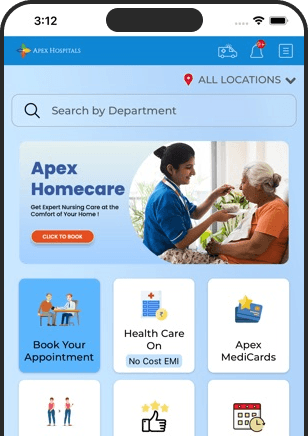Reimagining Healthcare in India: Reaching Lives Beyond the Metros
By:

Apex Hospitals
16-06-2025

Reimagining Healthcare in India: Reaching Lives Beyond the Metros
By Apex Hospitals, 13th June, 2025
For years, most of India’s healthcare system has been centred around metro cities, where it’s easier to find top specialists, big hospitals, and advanced treatments. But this focus has left a large part of the country behind. The truth is, over 65% of the population of India lives in Tier 2 and Tier 3 cities, where access to good, affordable healthcare is still a daily challenge. And as the population grows, so does the need, quietly but urgently, for better care in these towns and smaller cities.
As India evolves, our healthcare system needs to grow with it. We can’t focus only on big cities anymore. People in smaller towns and rural areas deserve the same kind of care. Now more than ever, we need healthcare that reaches everyone, no matter where they live. Because the real challenges and the real need are in the heart of Bharat.
Leaders like Dr. Shailesh Jhawar, Director at Apex Hospitals, are showing how it can be done. Building hospitals in smaller cities isn’t just about medical skills, it also takes smart planning, strong operations, and a deep connection with the local community. In a meaningful conversation with Vishal Seth, Managing Director at Protiviti India, Dr. Jhawar shares practical insights on what it takes to build a sustainable hospital chain in places where resources may be fewer, but the need for care is greater than ever.
Healthcare Beyond Metros: The Real Need
India’s smaller cities are home to millions of people who often lack access to timely and advanced medical care. As Dr. Jhawar points out, “Healthcare shouldn’t just be for people in metro cities. It should reach every part of India.” These regions are seeing a rise in demand for quality services, yet they face infrastructure, staffing, and operational challenges.
Healthcare Shouldn’t Have a PIN Code
Whether it’s Jaipur, Jabalpur, or Jhansi, access to timely and quality care shouldn’t depend on your geography. And yet, millions in smaller cities and rural regions struggle with delayed diagnoses, limited specialists, and poorly equipped facilities.
“Good healthcare shouldn’t be a privilege. It should be a right available to everyone, everywhere.”
The Rise of Smart, Scalable Healthcare Solutions
To bridge this gap, Dr. Jhawar has been instrumental in introducing Critical Care, Tele-ICU services, and modular hospital expansions—innovative solutions that bring critical care closer to underserved communities. These models are not only scalable but also cost-effective, helping to increase healthcare access without massive infrastructure investments.
The Tier 2–Tier 3 Opportunity: Where Volume Meets Value
Delivering super-specialty healthcare outside major urban hubs isn’t easy. Dr. Jhawar calls attention to a fundamental challenge: the volume-value mismatch.
“In smaller cities, you must have a certain population base to sustain specialties. Footfall matters; a hospital without enough patients cannot survive, no matter how advanced.”
Scalability, therefore, becomes key. Apex Hospitals focuses on high-potential areas, typically with a population of 25–30 lakhs, that can support long-term care delivery.
Working Capital and Operational Efficiency
In Tier 2 and Tier 3 cities, a significant percentage of patients—often 40–50%—are covered under Ayushman Bharat or state health schemes. These schemes bring volume but also mean fixed pricing and slower reimbursements.
So, how do you stay cash-flow positive?
“Cash flow is the most important part of this business. Managing working capital well is key. You need professionals who understand finance, not just medical operations, to handle it effectively.”
Dr. Jhawar emphasizes the importance of separating medical operations from financial management. His team uses data-driven decision-making and strong internal processes to monitor cost drivers, maintain healthy cash flows, and scale smartly.
Modular Growth: Scaling Hospitals with Flexibility and Focus
Rather than building large hospitals upfront, Apex follows a modular hospital development model. They typically start with 100–200-bed facilities in target regions and gradually expand based on patient demand and service needs.
- Starting with critical care and emergency services
- Building community trust and visibility
- Gradually layering in super-specialties
- Focusing on 6–7 key therapeutic areas
- Incorporating robotics and medical innovation to differentiate offerings
This stepwise growth approach includes:
“Each hospital is at a different stage. Some are mature, some are developing medical USPs. But our DNA stays the same—community-first, sustainable, and innovation-led.”
Final Thoughts: Rebuilding Healthcare Where It's Needed Most
The next decade of Indian healthcare will be defined not by the metros, but by what happens in smaller cities and towns. Leaders like Dr. Jhawar are showing that with the right mix of strategy, empathy, and efficiency, it's possible to build hospital chains that serve millions—not just profitably, but meaningfully.
For investors, policymakers, and healthcare entrepreneurs, this is more than an opportunity. It's a responsibility to create systems that are resilient, inclusive, and ready for the future.
FAQS
Related Articles
Connect With Us
Health In A Snap, Just One App.
KNOW MORE



































































































